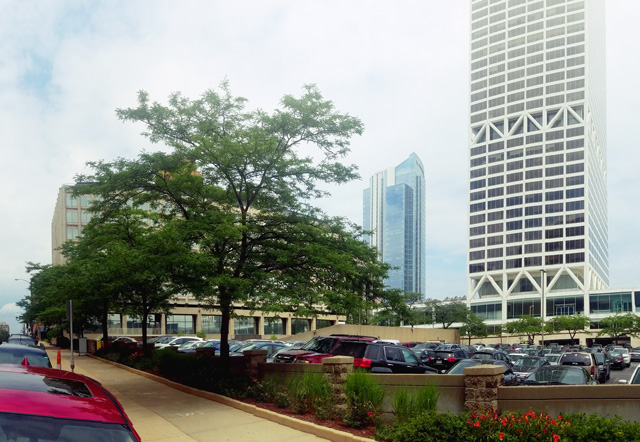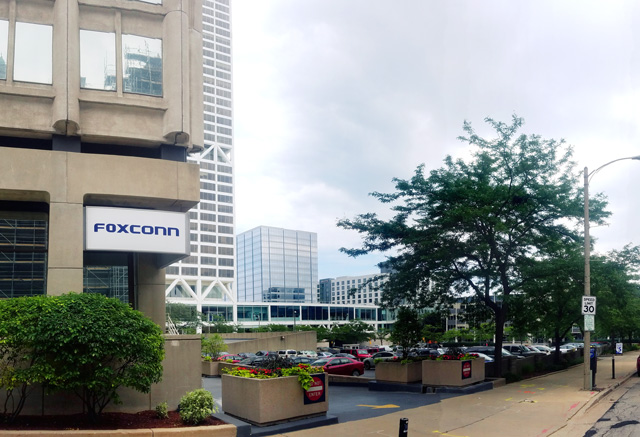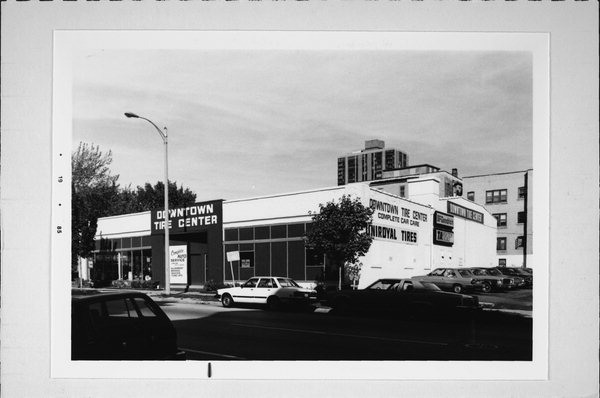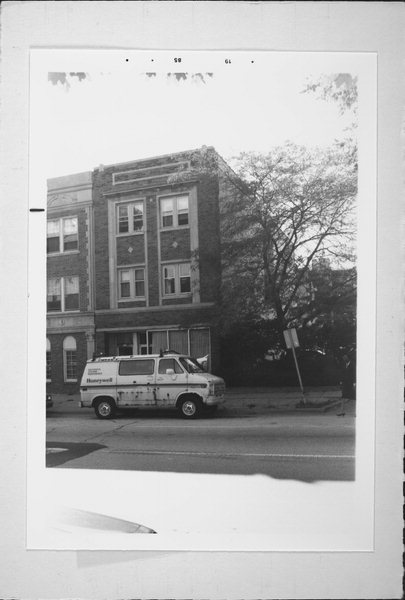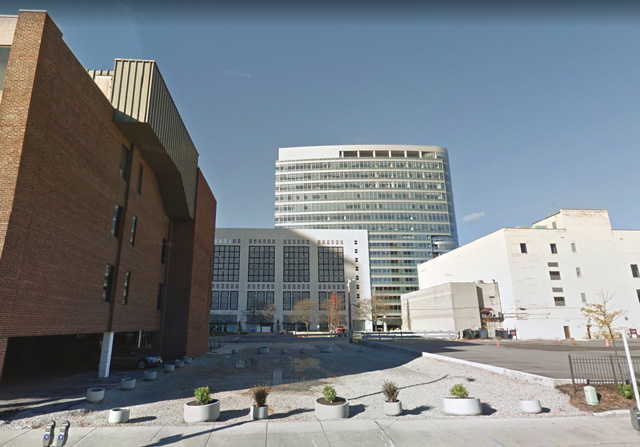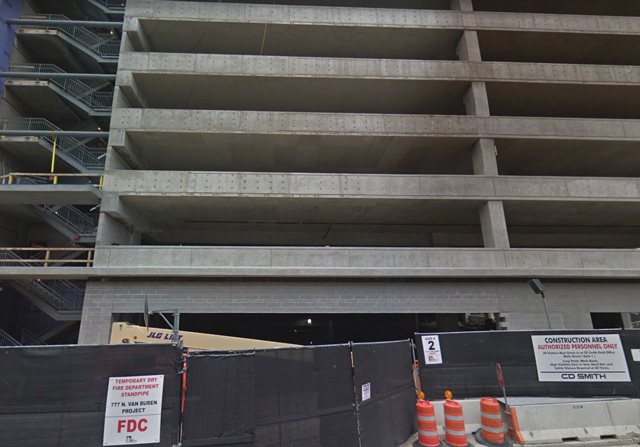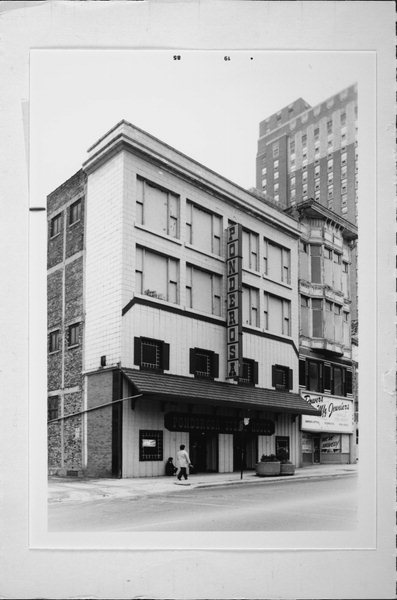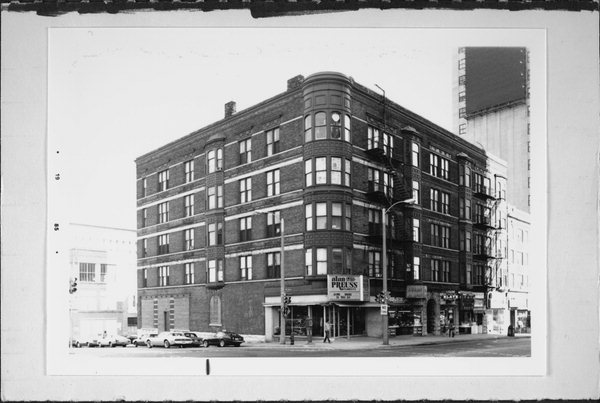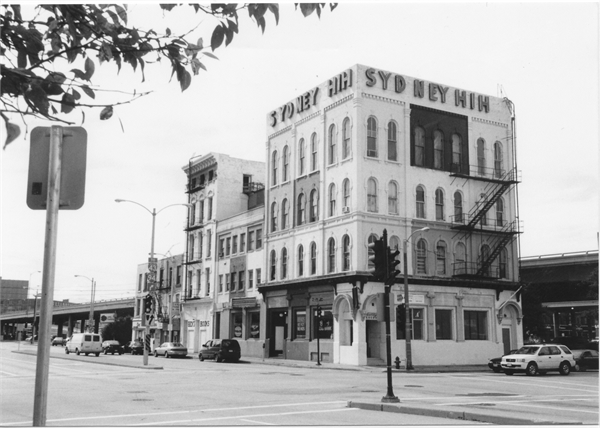Cities are malleable and fallible, and their composition and skyline flow and shift as the ages progress. I try to avoid preservation simply for the sake of nostalgia, but seeing any building replaced by a parking lot, especially a surface lot, feels like a backwards move. Parking lots are an unexciting, passive place with no visual interest. They are areas you walk around or through to get to the places you actually want to be.
I talked to two professors from the University of Wisconsin-Milwaukee about the effects of replacing buildings with parking lots: Robert Greenstreet, Professor of Architecture and Dean of Architecture & Urban Planning, and Arijit Sen, Associate Professor of Architecture.
"Most people don’t see it, but when you become aware of it, you begin to see the closed-off windows and ghost images left on the ground where a building used to be," Sen says.
Here are some examples of where people and potential were pushed out for parking.
610 N. Jackson St.
In 1984, three buildings used to stand in the shadow of the Firstar building. Now the U.S. Bank building looms over a surface parking lot while the Northwestern Mutual building peaks into view.
Historic buildings are razed for any number of reasons, some more honorable than others, such as forces of nature, or simply being in the way of a new, exciting project, or — most unfortunately — poor stewardship and decay.
626 N. Jackson St.
Here is a view from the opposite direction, in which you can clearly see a beautiful cream city brick building that was home to the YWCA. When the building was demolished, it was turned into a surface parking lot.
No matter what the reason is for demolition, it's still a shame to see a classic cream city brick building replaced with the personality of a parking lot. It removes the three-dimensional history and replaces it with a flat surface that can only hold two states: empty or littered. Nobody looks at a parking lot and says, "That is beautiful," nor do travelers book their vacation plans based on the aesthetics and convenience of parking lots.
628 E. Michigan St.
Just around the corner on the same block, this modest brick office building was razed and replaced with the same surface parking. This building, plus the three others above, had comprised of at least 26 floors of useable space, all of which have been reduced to one level of surface parking.
Greenstreet believes, "There is only so much retail a city can provide. You don't want a building that mostly remains empty," so the key is finding creative ways to keep activity on the ground floor.
Sen believes density also enhances privacy. "Visual control is a policing thing. When you have all these open spaces, the city becomes a panopticon, where you can see everything all at once."
830 N. Van Buren St.
The Downtown Tire Center held presence in 1984. It doesn't fit into the romantic idea of cream city high rises, but I relish in the creative possibilities of a standing edifice, working within the boundaries for you to create something new and unique. It has nevertheless been razed and turned into a surface parking lot.
I hear a lot of people complain that Milwaukee has a parking problem, but nearly every block has its own lot or multi-story garage. There are more than 100 parking facilities in the city that rarely, if ever, reach capacity.
Truly, Milwaukee has a parking perception problem. There are plenty of places to park, but people want FREE parking, especially when it’s right outside their door. But parking costs the city more than just revenue in taxes; surface lots form the black holes of a city’s soul.
767 N. Van Buren St. / 773 N. Van Buren St.
Sometimes classic buildings are demolished for ideas that are bigger and better, but as is the case with these two, sometimes classic buildings are demolished for the parking lots that sit next door.
It’s arguable whether parking structures are more or less onerous than surface parking: They make better use of the space, but nevertheless encourage more people to drive and discourage use of public transit.
Greenstreet told me it’s the economics of parking lots that drives the style of lot that gets built. "A parking garage costs six times more than a surface lot, and it's 13 times more expensive to build underground. Milwaukee’s parking fees are relatively cheap compared to the surrounding area, so there is not a strong economic incentive."
Still, there are some nicer looking parking garages and some people are trying some fun things to occupy those spaces in interesting ways.
795 N. Van Buren St.
Looking the opposite way down the 700 block of Van Buren was this modern-looking office space, which, despite its windowless construction, held onto a modern personality and charm from the 1960s.
Sometimes the destruction of a building offers a glimpse at another, arguably more worthwhile piece of design, such as the Cathedral of St. John the Evangelist across the street. But removing buildings also destroys the natural rhythm of the city, and reveals the flat, un-designed alleyways behind.
"The sidewalls of most buildings are not designed to be seen," said Greenstreet. Because they usually sit next to an alleyway, or about another building, "they are usually a windowless, unrelenting and undecorated plane."
"You don't want to live in a world where you can see everything," said Sen, "Life is better with surprises."
The office was demolished in 2014 and turned into a surface parking lot, but maybe with the construction of a parking garage next door, we won't need the dozen parking spaces that this area provides, and we can find a more creative use for this land in the future.
N. Broadway between Clybourn St. and St. Paul Ave.
Installing freeways through big cities was a destructive process, razing entire swaths of land. This literally paved the way for more cars, which literally means paving the way for more parking, which further destroys the city’s history.
The Third Ward is historic thanks to the preservation of most of its beautiful brick buildings, but these cheese shops and grocery stores disappeared in the name of progress and parking.
The land beside and underneath freeways is often left barren and unused, but there are creative ways to activate these destroyed spaces, from ice rinks to bike paths to skate parks.
803/813 E. Wells St.
The 800 block of Mason and Wells used to be filled with Neoclassical, Mediterranean revival and the Elizabethan-styled apartments above. Built between 1898 and 1916, they were razed to make way for a Northwestern Mutual highrise.
This supposedly falls into the "bigger and better’ category, but the new construction — built in 1989 — looked dull and dated almost immediately, and especially now, compared to its hyper-modern counterpart across the street, which was built in 2018.
Alas, a parking lot now sits were these two apartments used to stand.
400-block of W. Wisconsin Ave.
The surface parking lot on the 800 block of W. Wisconsin Ave. has been the subject of some revitalization chatter, but attempts to activate the space in a meaningful way have come up short.
"A parking lot is nobody’s territory" says Sen. "This is why we are scared of parking lots at night. They allow people to come in and take over."
"Small, high quality places give you a breather from urban activity," says Greenstreet.
A mural from Reginald Baylor, some ground works and some picnic tables admirably attempt to provide the essence of a park without any greenery, but the harsh reality is that the space is not meaningful because nobody wants to hang out in a parking lot … especially when it’s in view of three other parking structures.
626 W. Wisconsin Ave.
The Norman Flats, built in 1888 and demolished just over 100 years later thanks to a historic fire in 1991, rank among the oldest buildings in this list that have disappeared and left us with surface parking.
Removing buildings destroys street walls, which are a "continuous set of building façades with similar heights that are set back a similar distance from the property line." This erodes the comfort and uniformity of a city.
Furthermore, installing parking lots create driveways that intersect with sidewalks, which makes for a more dangerous, less welcoming experience. The smaller the chance a person is going to get run over by a car, the safer and the happier they’ll be.
738 N. Old World 3rd St.
The Princess Theater had something of a storied history and was primarily a porn theater until its ultimate destruction. The Brass Rail next door was home to a mob run jazz club where named musicians occasionally played, which nearly included John Coltrane. This whole section of the block was eventually torn down to make room for a hotel which never materialized. The land has since been relegated to surface parking.
300 W. Juneau Ave.
The Sydney Hih building held a lot of historic and nostalgic value as a bohemian artist community and venue, which included a pre-"Nevermind" appearance of Nirvana, but poor stewardship led to deteriorating conditions, which ultimately got the building razed. The complex was a unique patchwork of artistic endeavors, but now the space stands empty.
You can see the Park East Freeway, which ran behind the Sidney Hih for several decades until it earned the honor of being one of the few freeways in the nation to be exorcized from within the city. That area sat undeveloped for quite some time, but has since seen a flourish of revitalization which has transformed the aesthetic of that section of the river.
With the construction of the Fiserv Forum just down the street, there is hope that this lot will be re-valued and someone will return to energize the space, but there's also a good chance this surface lot will instead be transformed into a parking garage.

